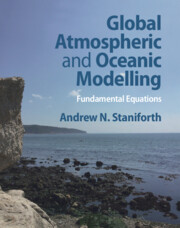
-
Select format
-
- Publisher:
- Cambridge University Press
- Publication date:
- 08 April 2022
- 28 April 2022
- ISBN:
- 9781108974431
- 9781108838337
- Dimensions:
- (254 x 203 mm)
- Weight & Pages:
- 2kg, 816 Pages
- Dimensions:
- Weight & Pages:
You may already have access via personal or institutional login
Book description
Combining rigorous theory with practical application, this book provides a unified and detailed account of the fundamental equations governing atmospheric and oceanic fluid flow on which global, quantitative models of weather and climate prediction are founded. It lays the foundation for more accurate models by making fewer approximations and imposing dynamical and thermodynamical consistency, moving beyond the assumption that the Earth is perfectly spherical. A general set of equations is developed in a standard notation with clearly stated assumptions, limitations, and important properties. Some exact, non-linear solutions are developed to promote further understanding and for testing purposes. This book contains a thorough consideration of the fundamental equations for atmospheric and oceanic models, and is therefore invaluable to both theoreticians and numerical modellers. It also stands as an accessible source for reference purposes.
Reviews
‘Andrew Staniforth has produced a comprehensive and insightful book on the mathematical foundation of global atmosphere and oceanic modelling. For different geophysical fluid applications, he guides us masterfully from the first principles of fluid physics to their evolution equations. The book covers all the fundamental aspects of these equations including conservation laws and exact nonlinear solutions. This brilliant book is ideal for introducing graduate students to the subject matter as much as it is relevant for experts as a reference book.’
Gilbert Brunet - Bureau of Meteorology, Melbourne
‘Well, this is an impressive book. It covers both the equations of motion and how those equations and their approximations can be used in models of the ocean and atmosphere. It is clearly written, careful and thorough, with a range and a depth that is unmatched elsewhere. It will be of immense value both to those interested in the fundamentals and those wishing to build models that have a sound foundation. It will be a standard for years to come.’
Geoffrey K. Vallis - University of Exeter
‘This is the textbook I wish I’d had as a graduate student and course instructor! This is an incredibly comprehensive resource for students and researchers alike. I am confident the book will become the go to reference on atmospheric and oceanic modelling for the 2020s and beyond.’
Andrew Weaver - University of Victoria
‘Global Atmospheric and Oceanic Modelling is bound to become a classic in the literature of Geophysical Fluid Dynamics. Written by a multi-decade insider to the design of the numerical “dynamical cores” that are at the heart of the models employed for both weather prediction and climate change projection, the book provides a meticulously documented development of dynamically and thermodynamically self-consistent sets of equations that are employed to describe the evolution of these geophysical fluids. Highlights of the book include a careful development of the influence of the ellipsoidal shape of the planet which acts through the gravitational field on the evolution of these fluid domains.’
W. Richard Peltier - University of Toronto
‘This text is a tremendous resource for anyone looking for a rigorous, thorough treatment of the fundamental equations needed for the development of dynamical cores of numerical models for weather and climate, especially for those interested and/or involved in model design and development. The treatment is detailed, general, and exact without ad-hoc approximations or simplifications. This includes a more truthful representation of variations in gravity due to the geometry of the system. Andrew Staniforth offers the reader unique insights from his experience of an entire career as a leading scholar in the field.’
Thomas Birner - University of Munich
'… comprehensive and rigorous … Graduate students and advanced researchers with interests in atmospheric, oceanic, or general climate modeling will find this treatise invaluable … Highly recommended.'
M. Alam Source: Choice
Contents
Metrics
Altmetric attention score
Full text views
Full text views help Loading metrics...
Loading metrics...
* Views captured on Cambridge Core between #date#. This data will be updated every 24 hours.
Usage data cannot currently be displayed.
Accessibility standard: Unknown
Why this information is here
This section outlines the accessibility features of this content - including support for screen readers, full keyboard navigation and high-contrast display options. This may not be relevant for you.
Accessibility Information
Accessibility compliance for the PDF of this book is currently unknown and may be updated in the future.


